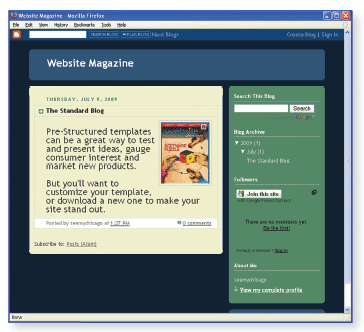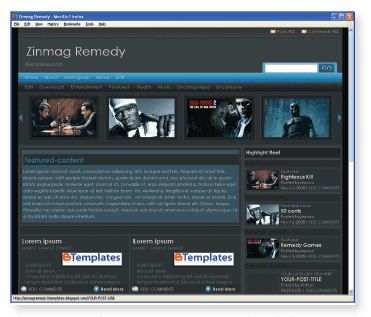Rethinking the Use of Pre-Structured Design

Leveraging Design Templates for Power Marketing
In a perfect world, website and domain owners would be able to release new sites with fresh and innovative designs rapidly, impress users and secure top positions on search results pages with ease.
The challenge is that we're not all blessed with the intrinsic sensitivity to "what looks good" - that preternatural ability to know what colors, elements and images will make a positive impact on the users visiting our site. Instead of releasing websites as quickly as we dream them up, ideas (and the sites that follow) often fall by the wayside, despite our best intentions.
The solution might just reside in pre-structured design templates.
Many years ago, in an effort to promote a Web-based service, I created an information-rich website on a separate domain. Without formal design skills at the time, leveraging a freely available design template as the framework seemed like a good idea. It allowed me to populate all the information I had on the site quickly using WYSIWYG (what you see is what you get) design software. What was the result of rich content plus an appropriate design template? After 24 hours, the new site was born and it actually became more profitable than the original Web service I intended to promote in the first place.
Leveraging design templates provided either free or with a small fee eases the financial burden and the time of creating new designs for the exclusive purpose of marketing content. Ideas can materialize and launch as fast as they were conceived. That flexibility combined with ingenuity can lead to unexpected success, as well as a way to stay a step ahead of the competition. On the other hand, custom websites can run into the hundreds or thousands of dollars (even for just a five-page website) and there is no guarantee that you will like the final product. Plus, fundamental elements of the idea can quickly change, causing even greater customization needs, increased financial commitment and precarious delays. While templates may not be right for every Internet enterprise (especially those employing fulltime designers), it does offer those with big ideas but little design experience or trouble circumventing barriers an opportunity to embrace innovation and test new grounds.
There are hundreds of providers online who do an amazing job of aggregating design templates from freelance or agency designers looking to make a name for themselves in the hyper-competitive world of Web design. Some even staff teams of talented designers. While an educational practice for some and even a networking and promotion practice for many designers, the value offered to users of these templates is immeasurable. Notable providers such as TemplateRover.com, TemplateMonster.com, OSWD.org, layoutbank.com and others have thousands of design templates from which marketers, website and domain owners can choose.
Chances are high that you have seen the same design (or at least its elements) on more than one site. Spend a few minutes navigating the Web in some under-served or over-served niches and the problem becomes magnified - critical users will often leave the website if you're not offering a unique design experience. But with a few simple modifications you can satisfy even the harshest of design critics.
What parts of these templates can be modified to separate your site from the competition? Some elements of standard templates to consider modifying include: color palette which is easily adjustable within CSS files; size and font of headings and subheadings; and core header image available within most basic website design templates. Tapping into the supply of available Creative Commons images is one method to find images that fit your plan and are free and legal.
Savvier users can make specific customizations including the size and placement of sidebars or footers, the presence of primary and secondary navigational elements, the inclusion of background patterns (should the site itself warrant such treatment) or even replacing entire navigational elements. In most, if not all pre-structured design templates, some modification or customization is required, even if it is simply displaying a company logo.
Design templates are by no means the answer to serious design issues. It should also be noted that there is no replacement for a custom design that takes into consideration the uniqueness of a business (or an idea) requiring a sophisticated presentation in order to impress users and support the brand.
Choosing a Template
It's difficult, if not impossible, to determine the most used pre-structured design template on the Web. But there are certainly a few that stand out (if not scream out) as popular among template users. Most design template resources provide a rough idea of how many times a template has been downloaded and that figure can provide a guide on what to stay away from if you want the design you choose to be unique. Case in point, popular template RedTie has been downloaded a whopping 172,000 times since first being added to OSWD.org.
However, don't dismiss a template purely on the number of downloads - it can indicate a platform's stability. If a template is rarely downloaded but has been available for months or years, that might indicate it's difficult to use or customize. Also check for active demos because they can provide a glimpse of the customization possibilities. And look for user comments to get an idea of any pre-existing flaws or issues.
As noted previously, innovative design is a challenge to create and can get expensive. Despite the loud guffaws of professional designers, there is a place for design templates. Realize they serve well in certain instances to provide a framework to take to Web designers and can provide an unmatched level of inspiration for your next big idea.

Above is a standard template from the most popular blogging platform, Blogger.com. No doubt, you have seen countless websites using this template, or one very similar. The problem then, is that users immediately get the impression that this is an amateur creation and not a serious Web enterprise. You might be an amateur, but you don't have to look like one.

This image is another Blogger template, but one that is highly customized. While the fundamental design elements remain the same and the interface is still simple, users will have a much harder time dismissing this as a novice production. Templates like this are easy to find, download and implement, and can be an easy way to launch new websites and ideas. Visit https://btemplates.com for what is seemingly an endless number of options, or search for other templates online. Even basic templates can be easily customized by hand, and there are many tutorials online to help.

Subscribe to Our Newsletter!
Latest in Web Design









